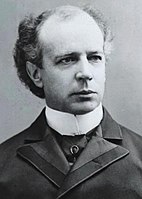| |||||||||||||||||||||||||||||||||||||
221 seats in the House of Commons 111 seats needed for a majority | |||||||||||||||||||||||||||||||||||||
|---|---|---|---|---|---|---|---|---|---|---|---|---|---|---|---|---|---|---|---|---|---|---|---|---|---|---|---|---|---|---|---|---|---|---|---|---|---|
| Turnout | 70.3%[1] ( | ||||||||||||||||||||||||||||||||||||
| |||||||||||||||||||||||||||||||||||||
 | |||||||||||||||||||||||||||||||||||||
The Canadian parliament after the 1908 election | |||||||||||||||||||||||||||||||||||||
| |||||||||||||||||||||||||||||||||||||
The 1908 Canadian federal election was held on Monday October 26, 1908 to elect members of the House of Commons of Canada of the 11th Parliament of Canada. Prime Minister Sir Wilfrid Laurier's Liberal Party of Canada was re-elected for a fourth consecutive term in government with a majority government. The Liberals lost four seats and a small share of the popular vote.
Sir Robert Borden's Conservatives and Liberal-Conservatives won ten additional seats.
This was the first election in which Alberta and Saskatchewan voted as provinces. Following their creation in 1905, the two new provinces continued to be represented by MP's initially elected under the old Northwest Territories riding boundaries, some of which straddled the new provincial border. The remainder of the Northwest Territories that previously had Parliamentary representation lost it, although parts of the NWT would gain or re-gain representation after being added to Manitoba, Ontario and Quebec in 1912. A seat would not be created for the NWT itself again (which then contained the modern NWT and Nunavut) until 1949.
This is the most recent election in which a prime minister was able to lead their party to a fourth consecutive mandate.
- ^ "Voter Turnout at Federal Elections and Referendums". Retrieved March 10, 2019.
Cite error: There are <ref group=lower-alpha> tags or {{efn}} templates on this page, but the references will not show without a {{reflist|group=lower-alpha}} template or {{notelist}} template (see the help page).

